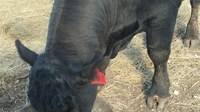Pinkeye and Foot Rot a Rancher’s Headache
Producers have several options for controlling flies.

Fly problems are prevalent in some parts of North Dakota this year, North Dakota State University Extension livestock specialists warn.
Horn, face and stable flies all are irritating to cattle, but stable flies have been particularly bothersome.
“They will bite and irritate the animals on the legs and belly, and control of these pests is very difficult,” says Gerald Stokka, NDSU Extension veterinarian and livestock stewardship specialist.
“Too many flies feeding on cows can lead to a decrease in weaning weight,” notes Karl Hoppe, Extension livestock systems specialist at NDSU’s Carrington Research Extension Center. “It’s generally accepted that 100 flies per side or 200 flies total per beef cow is the point where decreased weaning weight will cause economic losses.”
The main fly control methods are insecticide-containing ear tags; pour-on, spot-on and spray-on insecticides; insecticide dust bags; ropes filled with oil and insecticide; oiler/rubbers; mister/foggers; and sprayers.
Another option is a walk-through mechanical flytrap. As cattle walk through the trap, a series of strips made of canvas or old carpet dislodge most of the flies. Light attracts the flies to the screened sides of the trap and they can’t escape. Visit https://extension2.missouri.edu/G1195 for more information about this system.
Products such as Rabon and IGR can reduce fly population if they are fed to cattle early enough, which is two to three weeks before moving the cattle to pasture. These products need to be continued throughout the summer, Stokka says. They inhibit larval growth of flies that lay eggs in manure patties.
Flies will migrate from herd to herd, so if the neighbor doesn’t control flies, the flies will move to other herds, Hoppe says. Rotating cattle to pastures some distance away can be helpful because new populations of flies take some time to develop.
To find relief from fly bites when fly pressure is high, cattle will crowd or bunch together, or they may stand in stock ponds or other water. The water reduces the number of bites from stable flies on the legs, and the mud creates a shield for protection later. Also, a wet tail provides an effective fly swattter.
However, standing in water to avoid flies creates an opportunity for the soft tissue between the toes to get soft and prone to foot rot infections, Hoppe says. The infection is painful, so the cow will limp and even leave the herd to rest. Cows also will lose weight because limping keeps them from grazing.
“Appropriate antibiotic therapy is necessary to control the infection and inflammation before the cow develops permanent damage to the foot,” Stokka says.
Cattle also will stand in groups, stomping the ground and creating dust to fight flies. This can lead to eye irritation. Face flies will feed on the eye secretions and can transmit bacteria that may lead to pink eye. Antibiotic therapy is necessary to decrease the infection before the cow develops a permanent eye lesion, which could limit its vision.
“While timely administration of antibiotics can help in the healing process of foot rot and pinkeye, it can be rather difficult to sort cattle and restrain them for injecting antibiotics,” Stokka says.
Many ranchers have opted to use dart guns to help deliver antibiotics to cattle while the animals are grazing, but the best option is proper restraint and treatment, according to Stokka. He recommends producers consult with their veterinarian about the appropriate antibiotic choices.
“However, if this method of treatment is used, use only air pump equipment,” he adds. “Spend enough time to get within 15 to 20 feet of the animal, and use the appropriate dose for the size of the animal.”
While fly control is needed, keeping up with fly pressure is difficult, the specialists say.
“Use different insecticides to help control fly populations,” Hoppe advises. “Consider adding larvicides in the mineral mix or periodic applications of fly control products, or consider using rotational grazing techniques and natural fly predators.”
NDSU Agriculture Communication - July 27, 2018
| Source: | Karl Hoppe, 701-652-2951, karl.hoppe@ndsu.edu |
|---|---|
| Source: | Gerald Stokka, 701-231-5082, gerald.stokka@ndsu.edu |
| Editor: | Ellen Crawford, 701-231-5391, ellen.crawford@ndsu.edu |
